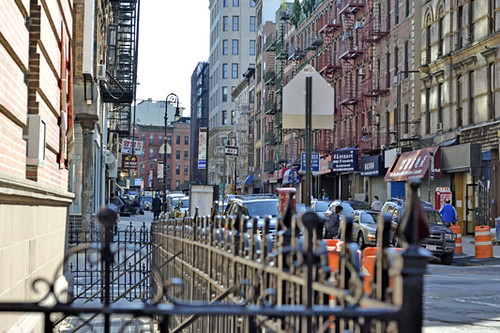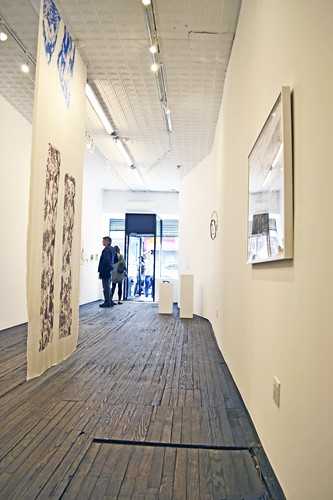 Mark Riffee There are 23 galleries on Orchard Street between Canal and Houston Streets and 71 total in the Lower East Side.
Mark Riffee There are 23 galleries on Orchard Street between Canal and Houston Streets and 71 total in the Lower East Side.In the more than three years since to The Times declared, ‘Here comes art,” with the opening of the New Museum space on the Bowery in 2007, the galleries indeed have come to the Lower East Side.
They occupy ground-level storefronts of skinny buildings with wrought-iron fire escapes zigzagging up their front facades on the seven tree-speckled blocks of Orchard Street between Canal and Houston and in the New Museum’s vicinity, too. They teeter on the edge of Houston. When Miguel Abreu opened his eponymous gallery at 36 Orchard Street in 2006, he can remember no more than four or five reputable galleries in the area. By the time the New Museum opened the next year, the Times counted two dozen. Now there are 75.
And the movement is inching northward.
So, East Villagers, is this a cultural revival on the scale of the 1980’s, which spawned the likes of Jean Michel Basquiat, Keith Haring, and Jenny Holzer? It’s hard to ignore the similarities. Like the East Village was, the Lower East Side has become a hotbed of intimate spaces at the bottom of tenement-style buildings run on low budgets by young gallerists eager to be the first to show New York’s freshest talent. The new scene is home to “very idealistic people who believe in the art. And that’s incredibly admirable,” says Pepe Karmel, 55, a professor of art history at NYU and a former art critic for The Times. “There’s really a place for that in the art world.”
Like their predecessors, the participants of this new scene put authenticity above all else. Mr. Abreu, 48, chose his Orchard Street location because adding to the Chelsea “super-market,” land of the “homogenous white cube,” wouldn’t allow any potential for distinction. In the Lower East Side, collectors and gallery-goers can expect to “discover something” and engage in “some kind of conversation with the work,” says Mr. Abreu.
In a similar fashion, the underground art movement that had been brewing for more than a decade in the East Village surfaced in the late 70’s as an alternative to the SoHo scene, which had sold out, according to many New York art enthusiasts. Edgy, authentic art was found below 14th Street and east of Broadway.
The neighborhood was economically depressed and ripe for expression, and the artists who provided it became rock stars. They “set out to take the city itself” as their canvas, writes Mr. Karmel in his essay “Oedipus Wrecks: New York in the 1980s,” recalling the Basquiat tags on buildings with witty observations questioning racial, socioeconomic, and spiritual relationships in New York; Haring’s spray-painted subway cars with elaborate calligraphy and painted canvases with cartoonish existential scenes; and Holzer’s “Truisms” printed on T-shirts and posters — “YOUR ACTIONS ARE POINTLESS IF NO ONE NOTICES” or “ABSOLUTE SUBMISSION CAN BE A FORM OF FREEDOM.”
Artist-run galleries and rowdy bars popped up everywhere, especially along First Avenue and Avenue A. But less than a decade after the scene exploded like a lit match thrown into a firework warehouse, it burned to embers. Most gallerists and artists “weren’t thinking about careers,” says Cary Abrams, a community contributor for The Local who watched the scene fizzle before it was ten years old.
The most successful of the lot moved to SoHo before the end of the 80’s, where they felt they could legitimize their legacies. Those who remained in the East Village were poisoned by a lethal cocktail of self-destruction and gentrification, says Mr. Karmel. He likens their demise to Nan Goldin’s “The Ballad of Sexual Dependency,” one of the most famous works to come from the era and what Mr. Karmel calls “a chronicle of people letting themselves be sexually exploited and destroying themselves with drugs.”
Ronald Sosinski, 62, director of the The Proposition on First Street just off Bowery, says there will never be a revival of the scene. He and Ellen Donahue, his business partner, opened E.M. Donahue Gallery for Contemporary Art on 11th Street between Avenues A and B in 1985 and stayed until 1987 when they escaped to SoHo. “I don’t think the opportunity exists the way it did,” says Mr. Sosinski. “We had so much great attention on us because the East Village was a burgeoning world.” As an art scene, he says, the Lower East Side is in a similar position. “It’s new. Rush there.”
In 2008, Lisa Cooley, 35, who had been working at the Andrea Rosen Gallery in Chelsea, did just that. She set her sights on the Lower East Side because first-floor storefronts were relatively affordable and pioneers like Mr. Abreu had paved the way for a new scene on Orchard Street, which as she says, “is becoming the backbone” of the movement.
Mr. Abreu and Ms. Cooley are pushing the Lower East Side in a more sustainable direction than their East Village predecessors did. They hope to mature into an autonomous scene that is more than just a breeding ground for artists who will eventually move on to more commercial galleries. “Stick it to the big galleries,” says Mr. Abreu with a smile.
Mr. Karmel agrees with Mr. Sosinski that the East Village won’t experience the new movement like it did in the 80’s or how the Lower East Side is experiencing it now. But who knows, as storefronts below Houston continue to fill up, maybe galleries will begin to spill over into our neighborhood.




